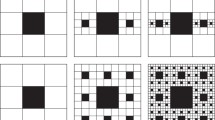Abstract
A simple practical method exists for classifying and comparing planar curves composed of connected line segments. This method assigns, a single numberD, the fractal dimension, to each curve.D=log(n)/[log(n)+log(d/L)], where:n is the number of line segments,L is the total length of the line segments, andd is the planar diameter of the curve (the greatest distance between any two endpoints). At one end of the spectrum, for straight line curves,D=1; at the other end of the spectrum, for random walk curves,D→2. Standard statistics are done on the logarithms of the fractal dimension [log(D)]. With this measure, trails of biological movement, such as the growth paths of the cells and the paths of wandering organisms, can be analyzed to determine the likelihood that these trails are random walks and also to compare the straightness of the trails before and after experimental interventions.
Similar content being viewed by others
Literature
Barenblatt, G. I. and A. S. Monin. 1983. “Similarity Principles for the Biology of Pelagic Animals.”Proc. natn. Acad. Sci. U.S.A. 80, 3540–3542.
Berns, G. S. and M. W. Berns. 1982. “Computer-based Tracking of Living Cells.”Exp. Cell Res. 142, 103–109.
Berg, H. C. 1983.Random Walks in Biology. Princeton Princeton University Press.
— and D. A. Brown. 1972. “Chemotaxis inEscherichia coli Analysed by Three-dimensional Tracking.”Nature 239, 500–504.
Bradbury, R. H. and R. E. Reichet. 1983. “Fractal Dimension of a Coral Reef at Ecological Scales.”Mar. Ecol. Prog. Series 10, 169–172.
Bradley, J. V. 1968.Distribution-free Statistical Tests. Englewood Cliffs, New Jersey: Prentice-Hall.
Broadbent, S. R. and D. G. Kendall. 1953. “The Random Walk ofTrichostronghlus retortaeformis.”Biometrics 9, 460–466.
Colquhoun, D. 1971.Lectures, on Biostatistics. Oxford: Clarendon Press.
Dunn, G. A. 1983. “Characterising a Kinesis Response: Time-averaged Measures of Cell Speed and Directional Persistence.” InLeukocyte Locomotion and Chemotaxis, Eds H. Keller and G. O. Till, pp. 14–33. Basel: Birkhauser.
Feller, W. 1957.An Introduction to Probability Theory and its Applications, 2nd edn. New York: Wiley.
Gail, M. H. and C. W. Boone. 1970. “The Locomotion of Mouse Fibroblasts in Tissue Culture,”Biophys. J. 10, 980–993.
Hatlee, M. D. and J. J. Kozak. 1981. “Stochastic Flows in Integral and Fractal Dimensions and Morphogenesis.”Proc. natn. Acad. Sci. U.S.A. 78, 972–975.
Hughes, B. D., E. W. Montroll and M. F. Schlesinger. 1982. “Fractal Random Walks.”J. statist. Phys. 28, 111–126.
Kareiva, P. M. and N. Shigesada. 1983. “Analyzing Insect Movement as a Correlated Random Walk.”Oecologia 56, 234–238.
Katz, M. J. 1984. “How Straight do Axons Grow?”J. Neurosci. (in press).
Katz, M. J. 1985.Templets and the Explanation of Complex Patters. Cambridge: Cambridge University Press (in press).
—, E. B. George and L. J. Gilbert. 1984. “Axonal Elongation as a Stochastic Walk.”Cell Motil. 4, 351–370.
— and R. J. Lasek. 1980. “Guidance Cue Patterns and Cell Migration in Multicellular Organisms.”Cell Motil. 1, 141–157.
Kraft, C. H. and C. van Eeden. 1968.A Nonparametric Introduction to Statistics. New York: MacMillan.
Lefevre, J. 1983. “Teleonomical Optimization of a Fractal Model of the Pulmonary Arterial Bed.”J. theor. Biol. 102, 225–248.
Loehle, C. 1983. “The Fractal Dimension and Ecology.”Speculations Sci. Technol. 6, 131–142.
Lovejoy, S. 1982. “Area-Perimeter Relation for Rain and Cloud Areas.”Science 216, 185–187.
Mandelbrot, B. B. 1977.Fractals: Form, Chance, and Dimension. New York: W. H. Freeman.
— 1983.The Fractal Geometry of Nature. New York: W. H. Freeman.
— 1984. “Fractals in Physics: Squig Clusters, Diffusions, Fractal Measures, and the Unicity of Fractal Dimensionality.”J. statist. Phys. 34, 895–930.
Mihram, G. A. 1972.Simulation. Statistical Foundations And Methodology. New York: Academic Press.
Peterson, S. C. and P. B. Noble. 1972. “A Two-dimensional Random-walk Analysis of Human Granulocyte Movement.”Biophys. J. 12, 1048–1055.
Segel, L. A., I. Chet and Y. Henis. 1977. A Simple Quantitative Assay for Bacterial Motility.”J. gen. Microbiol. 98, 329–337.
Skellam, J. G. 1951. “Random Dispersal in Theoretical Populations.”Biometrika 38, 196–218.
Sokal, R. R. and J. G. Rohlf. 1969.Biometry. The Principles and Practice of Statistics in Biological Research. New York: W. H. Freeman.
Trinkaus, J. P. 1984.Mechanisms of Cell Movement in vitro.Cells into Organs. The Forces that Shape the Embryo, Chap. 7, pp. 179–244. New Jersey: Prentice-Hall.
Author information
Authors and Affiliations
Rights and permissions
About this article
Cite this article
Katz, M.J., George, E.B. Fractals and the analysis of growth paths. Bltn Mathcal Biology 47, 273–286 (1985). https://doi.org/10.1007/BF02460036
Received:
Revised:
Issue Date:
DOI: https://doi.org/10.1007/BF02460036



